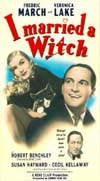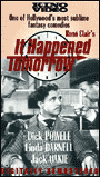FILM NOTES
FILM NOTES INDEX
NYS WRITERS INSTITUTE
HOME PAGE

Halloween Double Feature
René Clair Films
(American, 1942, 82 minutes, b/w, 16 mm)
Directed by René Clair
Cast:
Fredric March . . . . . . . . . . Wallace Wooley
Veronica Lake . . . . . . . . . . Jennifer
Robert Benchley . . . . . . . . . . Dr. Dudley White
Susan Hayward . . . . . . . . . . Estelle Mastersony
René Clair was one of the cinema’s great conjure artists. Even as a very little boy in Paris, he was an inveterate performer, and Clair’s puppet theater in his Les Halles apartment drew heavy crowds of fellow seven year-olds as first-nighters. He wrote poetry during high school, and seemed headed for a literary career. But Clair had been born in 1898, and that accident of chronology marked him for service in one of the century’s epic tragedies, World War I. He volunteered for service as an ambulance driver, and saw the blood running in the trenches, the foolish spending of thousands of lives by blustering generals, and the maniacal, pointless too-and-fro of the ‘campaigns’ on the Western Front. Whatever his artistic pretentions might have been, World War I turned Rene Clair into a surrealist.
A bad spinal injury and battle fatigue sent Clair home from the war, and he recuperated in a Dominican monastery. From there, he reentered the world. After performing in several films, Clair directed a textbook of surrealism, the masterful short film "Entr’acte," in 1924. Thereafter, he became one of the most innovative directors in world cinema, bringing the devices of surrealism into narrative cinema in such joyous masterpieces as THE CRAZY RAY (1925), THE ITALIAN STRAW HAT (1927), and UNDER THE ROOFS OF PARIS (1930). His 1930 film LE MILLION, alternately bitter and funny, explored the absurdities and psychic costs of modernity with brilliant cinematic flair. The film celebrated the idea of escape from the constrictions and cruelties of modern life, a theme Clair would return to in the dark decades ahead, when escape seemed to him a statement of personhood in an impersonal, violent world. As World War II approached, Clair shrank from false patriotism and noisy heroic speeches. He had seen the costs of such buffoonery, and to him, engagement with warlike sensibilities could only mean abandoning his own humanity to hate and carnage. Instead, he fled to America in 1941. Before war surprised America Clair could imagine no better place to escape reality than Hollywood. Then as now, he was right. Clair joined the French cinema community in exile in Hollywood, an august group that included directors Georges Duvivier and Jean Renoir, and actors Jean Gabin and Marcel Dalio. Clair was mystified by what he saw as Hollywood’s humorlessness, and set out to make films which displayed a sly, sensual wit, mixed with a soupcon of the sweet illogic of his surrealist days. In four features and episode of an omnibus film made during the War, Clair succeeded, with a touch so light it was almost diaphanous.
Clair’s American hosts at Paramount never understood his delicious humor, and I MARRIED A WITCH shows why. In the maelstrom of a world at war, Clair eschewed stern ‘message movies’ and false heroics. In the moment of films such as BATAAN, and while Paramount’s own flagwaver WAKE ISLAND was in production, Clair, whose back was still scarred by operations to correct his old war injuries, wanted to take his audiences as far from the battlefronts as possible. In I MARRIED A WITCH, he invited them back to the 17th Century, on a tour of American mores and manners led by a sultry blond witch, released by a fortuitous lightning bolt from the tree where her ashes have been buried since she was burned at the stake, and cursed for eternity, apparently for the crime of lasciviousness.
"Jennifer" (Veronica Lake) and her father "Daniel" (Cecil Kellaway) owe their centuries of imprisonment in the roots of an oak tree to the Wooley family, and they determine to take their revenge on the latest Wooley, a dour candidate for governor of Massachusetts. Jennifer is a Vargas calendar girl come to life, a dreamy concoction of curves and peek-a-boo hair, and she and her father energetically plot "Wallace Wooley’s" (Fredric March) downfall with fire and sex. Wallace’s campaign for office unravels as quickly as his engagement to a chilly, banned-in-Boston debutante ("Estelle Masterson," played by Susan Hayward). In the process, Clair uses the genre conventions of fantasy to toss a few curveballs past Hollywood's watchdogs of morality, the Hays Office. Perhaps Hollywood’s censors were too punchy from encounters with Clair’s colleague at Paramount, Preston Sturges, to notice the sleek, sexy innuendoes of I MARRIED A WITCH; indeed, the film had originally been planned for Sturges. Regardless, the film bears Clair’s worldliness and warm-hearted gift for the surreal into the very core of American hypocrisy.
Many years later, I MARRIED A WITCH’s delightfully erotic premise would be tortured into unrecognizable puritanism in television’s excruciating sitcom Bewitched, which got it exactly wrong: Jennifer is a witch who savors the power she has over others, who doesn’t miss a chance to make them do what her colossal, voluptuous Id bids them to do. She would never trade that power for a ranch house, a two-car garage and suburban respectability. Now, that would be purgatory.
Jennifer’s lusty, fiery pursuit overheats wintry Boston and quickly defrosts Wallace, but the film keeps us wondering until the last moment—can a Republican really find eternal happiness with Veronica Lake?
— Kevin Hagopian, Penn State University
(American, 1944, 85 minutes, b/w, 16 mm)
Directed by René Clair
Cast:
Dick Powell . . . . . . . . . . Larry Stevens
Linda Darnell . . . . . . . . . Sylvia
Jack Oakie . . . . . . . . . . Cigolini
Edgar Kennedy . . . . . . . . . . Inspector Mulrooney
In 1942, René Clair’s French films had established him, with Chaplin and Lubitsch, as one of the few comic geniuses in the director’s chair. World War II had exiled him from his homeland, however, and he found that his surreal, iconoclastic tastes annoyed the literalist, crass producers at Paramount, his home studio. Clair’s delightful 1942 fantasy I MARRIED A WITCH had so confused Paramount that the studio had sold the film for release to United Artists. Now, it was time to find another property, and Paramount presented several ideas to Clair. There was the Grahame Greene espionage drama, Ministry of Fear. Clair thought it too somber, and the project was eventually directed with distinction by Fritz Lang. Then Clair found Daphne DuMaurier’s Frenchman’s Creek in his mailbox. No, he said, the action drama of Restoration England was too stilted for him, and the film went to dependable Paramount contract director Mitchell Leisen.
Clair was looking for a comic allegory, a film that would assuage the emotional anguish of war at the same time it offered a humorous escape from it. He found it in a short story that, not surprisingly, had originally been discovered by Frank Capra. IT HAPPENED TOMORROW proceeds from a fascinating premise: what if a man could see tomorrow’s newspaper headlines today?
Once again, Paramount balked, and fobbed Clair and the project off to independent producer Arnold Pressburger and the more tolerant United Artists. Clair had always rankled at front-office interference while shooting on the Paramount lot. Free of surveillance, he allows himself to reprise some of the best comic effects of his early surrealist narratives. There are chases across rooftops, crossdressing, and an exuberant commitment to its farcical premise. Look magazine recognized Clair’s self-plagiarism. The final scene of rainy romance is among the most beautifully sentimental in American film. IT HAPPENED TOMORROW, said the magazine’s reviewer, "has taste, charm, and the old Clair touch." One of Clair’s greatest celebrants, French critic Jean Mitry, said that, with IT HAPPENED TOMORROW, Clair had regained the comic rhythm of LE MILLION.
In flashback, we see reporter "Larry Stevens" (Dick Powell) toasting his fresh promotion. "Pop," a philosophical old librarian talks about his own years in journalism, bemused as Larry’s youthful enthusiasm; the old man loves any news, yesterday’s, today’s, or, intriguingly, tomorrow’s news. He gives Larry a newspaper as they part. Larry finds the paper crammed with news that hasn't happened, and sets out to take advantage of his foreknowledge. Larry will spend a crowded, dangerous 24 hours with his remarkable gift, before beginning to wonder whether Pop wasn’t right after all.
After one more film in the U.S., TEN LITTLE INDIANS, Clair, like Jean Renoir and Georges Duvivier, would return thankfully to liberated France, glad to leave behind the strange customs of Hollywood, aware that, like Larry Stevens, he was a man out of time in Hollywood, a place that, while it manufactured dreams for the world, was itself too often bereft of the ability to suspend disbelief, to lie back and dream, to wonder, what if?
Does IT HAPPENED TOMORROW seem merely a charming, escapist fantasy? It isn’t. In 1944, Clair was living in the very vortex of history. Would tomorrow bring triumph or oblivion? Today, our world is just as uncertain, with global warming and other eco-disasters threatening daily, the specter of nuclear terror looming, and the sound of gunfire at work and school. If only we could hear tomorrow’s newscast today. But if we could, would we dare?
—Kevin Hagopian, Penn State University
For additional information, contact the Writers Institute at 518-442-5620 or online at https://www.albany.edu/writers-inst.
 I Married a Witch
I Married a Witch  It Happened Tomorrow
It Happened Tomorrow